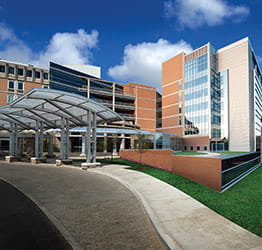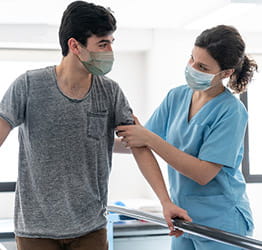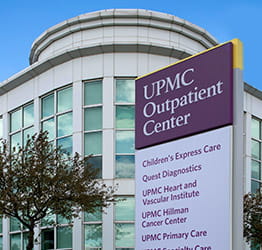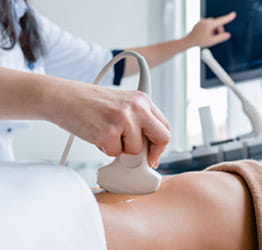What Types of Stroke Do We Treat?
We treat all types of stroke, including:
- Ischemic stroke — When a clot blocks a blood vessel in your brain.
- Hemorrhagic stroke — When a blood vessel in your brain ruptures, or when a brain aneurysm ruptures, causing bleeding in your brain.
- Transient ischemic attack (TIA) — Also known as a “mini-stroke,” a TIA occurs when blood flow to your brain is temporarily blocked. TIA causes stroke symptoms that last for a short time and then go away without causing permanent damage. A TIA is often a warning sign that a more severe stroke may happen soon.
UPMC uses advanced therapies to provide life-saving care for people who experience all types of stroke, restoring blood flow or controlling bleeding and improving outcomes.
What Are Stroke Treatment Services?
Stroke treatment options depend on the type of stroke you’re having, when your symptoms started, and your overall health and condition. Treatments by stroke type include:
Ischemic stroke and TIA treatment
Ischemic stroke and TIA treatment typically involves dissolving or removing blood clots to restore blood flow to your brain. Blood clots can be treated using medication, minimally invasive procedures, and surgery.
Hemorrhagic stroke treatment
UPMC surgeons treat hemorrhagic stroke medically and, if needed, perform minimally invasive procedures to drain blood from the affected area of the brain and repair the source of the bleeding.
What Stroke Conditions Do We Treat?
Our team provides advanced care for people who experience all types of stroke, including ischemic and hemorrhagic stroke or TIA.
Who’s Eligible for Stroke Treatment?
You may be eligible for stroke treatment if you are diagnosed with a stroke. Stroke symptoms include:
- Difficulty walking or moving.
- Dizziness.
- Loss of consciousness or seizure.
- Nausea or vomiting.
- Numbness or weakness in your face or limbs that may affect only one side of your body.
- Problems with balance or coordination.
- Severe headache.
- Trouble speaking or understanding.
- Vision problems in one or both eyes.
If you are having a stroke, your medical team will recommend the best treatment for your condition, age, overall health, and individual needs.
What Stroke Treatments Do We Offer?
Depending on your condition, the type of stroke you’re having, and the amount of time that has passed since your symptoms started, your treatment options may include:
Ischemic stroke treatments
Clot-busting medications
Clot-busting medications — also known as clot-dissolving drugs — can be given within four-and-a-half hours of when your symptoms start. Tissue plasminogen activator (tPA) is given through a vein in your arm after your doctor confirms that your stroke is caused by a blood clot and there is no evidence of bleeding.
Common clot-busting medications include:
- Alteplase (tPA) — The most common medication used to treat ischemic stroke.
- Tenecteplase (TNKase) — Used most at UPMC, it effectively dissolves clots with less risk of bleeding.
Endovascular thrombectomy
Endovascular thrombectomy (EVT) is a minimally invasive procedure for treating ischemic stroke by removing a blood clot that blocks blood flow to your brain.
The procedure involves using a small, thin tube called a catheter, which your doctor guides to the site of your blood clot. After the catheter is in place, your doctor will use a special device called a stent retriever to extract the clot, or other devices to suction or break it up.
The catheter also can be used to deliver a high dose of thrombolytic (clot-busting) drugs directly to the clot that is causing the stroke. This technique may make it more effective and cause fewer side effects than delivering clot-busting drugs to your whole body through an IV infusion.
UPMC neurologists and neurosurgeons played a key role in groundbreaking global EVT research and are among the most skilled in Pennsylvania and the U.S. at performing this pioneering procedure.
Stroke neurosurgery
In addition to advanced therapies, surgery may be performed following an ischemic stroke or transient ischemic attack (TIA) to prevent a recurrence.
Surgical techniques include:
- Carotid endarterectomy — Removes fatty deposits from your carotid artery, a major artery in the neck that supplies blood to the brain.
- Extracranial/intracranial bypass — Reroutes blood supply around a blocked artery by transplanting a healthy artery from another part of your scalp.
Hemorrhagic stroke treatments
Hemorrhagic stroke is usually treated with minimally invasive surgical procedures. These procedures can be performed through a small incision in the scalp or using a catheter that is inserted into a blood vessel and guided to the site of the brain bleed. Procedures include:
- Aneurysm clipping — Involves placing a metal clip around the base of an aneurysm to control bleeding.
- Embolization — Blocks blood flow to abnormal blood vessels.
- Endoscopic evacuation — Uses a small instrument with a camera to remove blood clots from your brain.
- Endovascular coiling — Uses small coils to block blood flow to an aneurysm.
- External ventricular drain (EVD) — Uses a thin, flexible tube called a catheter to drain fluid and blood from your brain.
- Flow diverters — Uses small devices to block blood flow to an aneurysm.
- Stereotactic aspiration — Uses imaging guidance and small surgical instruments to remove blood clots from your brain.
Post-stroke treatment
After your stroke, your care team may recommend other treatments to optimize your recovery, including:
Stroke rehabilitation
Stroke can cause lasting damage that may affect your ability to move, think, speak, and remain independent. UPMC offers a comprehensive stroke rehab program that includes physical, occupational, and speech therapy to improve:
- Balance and walking.
- Cognitive difficulties with thinking and memory.
- Language and speech.
- Swallowing and eating.
- Your ability to perform daily living activities, such as bathing and eating.
What Can I Expect?
UPMC stroke experts will diagnose your stroke quickly and develop a treatment plan to reduce your risk of disability or death.
Why Choose UPMC for Stroke Treatment?
When you choose UPMC for stroke treatment, you will receive:
- Access to world-class stroke neurology, vascular neurology, and neurosurgery expertise —UPMC is among the world’s best multidisciplinary stroke centers. When surgery is necessary, our neurosurgery team is experienced in advanced treatments, including traditional procedures and investigational approaches that are not widely available.
- A full range of treatment options — We offer nonsurgical and minimally invasive stroke care, as well as traditional open surgical procedures, allowing us to effectively treat all types of strokes while reducing your risk of complications.
- Multidisciplinary care — We partner with neurologists, rehabilitation specialists, and other medical experts to provide complete care that optimizes your recovery and quality of life.
















